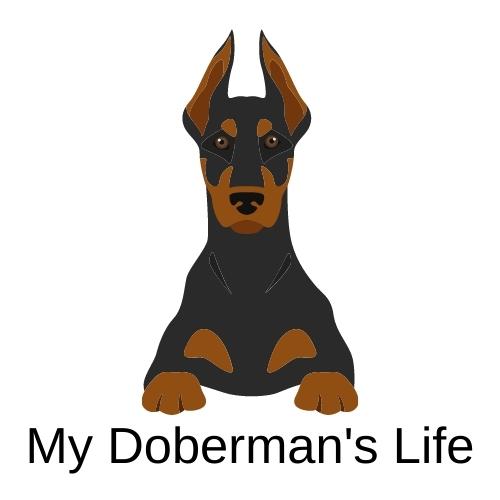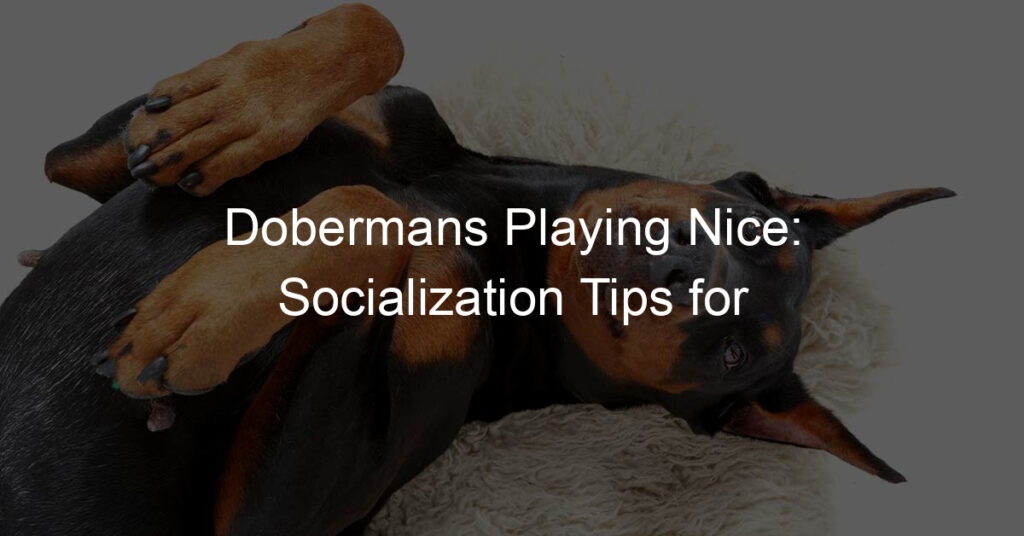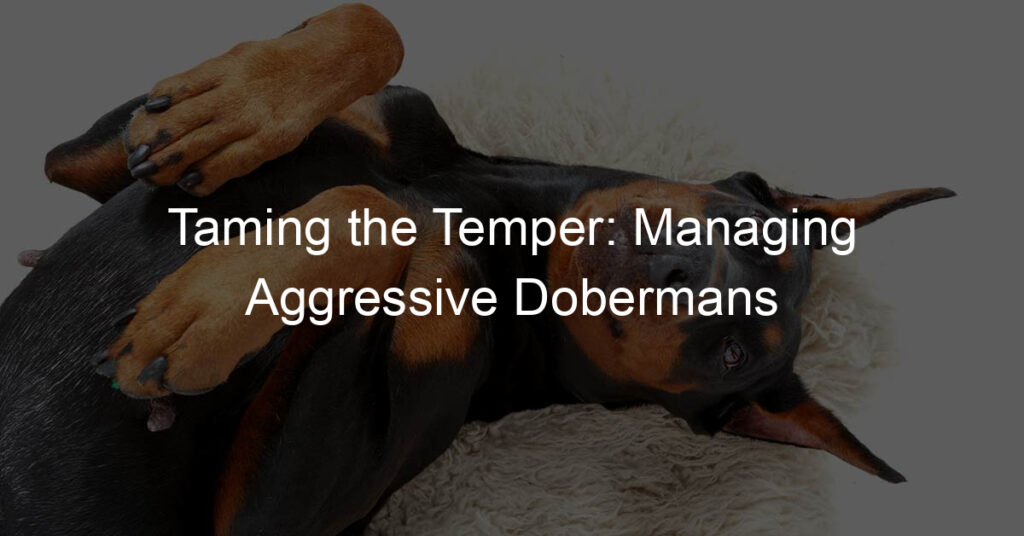
Introduction: Understanding Your Doberman Puppy’s Fear
Welcoming a Doberman puppy into your home is an exciting experience. However, it’s essential to understand that your new furry friend may experience fear and anxiety, just like humans. This introductory section will help you understand what fear in Doberman puppies means and the common causes of this anxiety.
- Defining fear in Doberman puppies
- Common causes of anxiety in Doberman puppies
Fear in Doberman puppies is a natural emotional response to perceived threats. It’s a survival mechanism that helps them avoid danger. Fear can manifest in various ways, including trembling, hiding, or aggressive behavior. It’s important to note that fear is not a sign of a ‘bad’ or ‘difficult’ puppy. Instead, it’s a sign that your puppy is uncomfortable and needs your help to feel safe.
Anxiety in Doberman puppies can be triggered by a variety of factors. These can include sudden changes in their environment, such as moving to a new home, loud noises, or being left alone for extended periods. Other common causes can be traumatic experiences, like a harsh scolding or a scary encounter with another animal. Understanding these triggers is the first step towards helping your puppy overcome their fears.
As we delve deeper into this topic, we will explore how to recognize signs of fear and anxiety in your Doberman puppy, the role of training in addressing these fears, and lifestyle adjustments you can make to manage your puppy’s anxiety. We will also discuss when to seek professional help and share a case study of a Doberman puppy who successfully overcame their fear.
Recognizing Signs of Fear and Anxiety in Your Doberman Puppy
Understanding your Doberman puppy’s behavior is crucial in recognizing signs of fear and anxiety. These signs can be both physical and behavioral. Let’s explore these signs in detail.
- Physical signs of a fearful Doberman puppy
- Shaking: Your puppy may tremble or shake when they are scared.
- Excessive panting or drooling: If your puppy is panting or drooling more than usual, it could be a sign of anxiety.
- Loss of appetite: Fear can cause your puppy to lose their appetite.
- Excessive grooming: Over-grooming or licking can be a sign of stress in dogs.
- Behavioral signs of anxiety in Doberman puppies
- Aggression: Fear can cause your puppy to become aggressive as a defense mechanism.
- Excessive barking or howling: If your puppy is making more noise than usual, it could be a sign of anxiety.
- Restlessness: An anxious puppy may have trouble settling down and may seem to be constantly on edge.
- Chewing or destruction: Anxiety can lead to destructive behavior like chewing on furniture or shoes.
Physical signs are often the first indicators of fear in your Doberman puppy. These can include:
It’s important to note that these signs can also be symptoms of physical illness, so it’s always a good idea to consult with your vet if you notice any of these behaviors.
Behavioral signs of anxiety can be more subtle than physical signs, but they are just as important to recognize. These can include:
Remember, these behaviors can also be a normal part of puppyhood, but if they are excessive or causing problems, it could be a sign of anxiety.
Recognizing these signs of fear and anxiety in your Doberman puppy is the first step towards helping them feel safe and secure. In the following sections, we will explore how to address these fears through training and lifestyle adjustments.
Addressing Fear in Puppies: The Role of Training
Training plays a crucial role in helping puppies, especially Dobermans, overcome their fears. It’s not just about teaching them commands, but also about building trust and understanding. Let’s delve into the basics of Doberman puppy training.
Doberman Puppy Training Basics
Training a Doberman puppy requires patience, consistency, and a positive approach. Here are some fundamental steps to follow:
- Establishing Trust with Your Doberman Puppy
- Importance of Consistency in Training
- Using Positive Reinforcement to Manage Fear
Trust is the foundation of any successful training. Spend quality time with your puppy, engage in play, and provide a safe environment. This will help your puppy feel secure and more receptive to training.
Consistency is key in training. Use the same commands and gestures each time. This helps your puppy understand what is expected of them, reducing their anxiety and fear.
Positive reinforcement is an effective way to manage fear in puppies. Reward your puppy with treats or praise when they show courage or behave well. This encourages them to repeat the behavior, gradually reducing their fear.
Remember, training is not a one-size-fits-all approach. Each Doberman puppy is unique and may respond differently to training methods. It’s important to be patient and adapt your training to suit your puppy’s needs.
| Training Element | Description |
|---|---|
| Trust | Build a strong bond with your puppy through quality time and a safe environment. |
| Consistency | Use the same commands and gestures each time to help your puppy understand what is expected. |
| Positive Reinforcement | Reward your puppy with treats or praise when they show courage or behave well. |
Training is a journey, not a destination. It’s about building a bond with your Doberman puppy that’s based on trust, understanding, and mutual respect. With patience and consistency, you can help your puppy overcome their fears and grow into a confident, well-behaved dog.
Advanced Anxiety Training for Puppies
After understanding the basics of Doberman puppy training, it’s time to delve into more advanced techniques. These methods are specifically designed to help manage and reduce anxiety in your Doberman puppy. Let’s explore two effective strategies: desensitization and counter-conditioning.
- Desensitization Techniques for Fearful Doberman Puppies
- Counter-Conditioning Strategies
Desensitization is a technique that involves gradually exposing your puppy to the things that scare them. The goal is to help them become less sensitive to these triggers over time. For example, if your Doberman puppy is afraid of loud noises, you might start by playing a recording of the noise at a very low volume. As your puppy gets used to the sound, you can slowly increase the volume. Remember, this process takes time and patience. It’s important to move at a pace that’s comfortable for your puppy to prevent causing more fear or anxiety.
Counter-conditioning is another effective strategy for managing anxiety in puppies. This technique involves changing your puppy’s emotional response to the things that scare them. For example, if your Doberman puppy is afraid of strangers, you might give them a treat every time a new person comes into your home. Over time, your puppy will start to associate strangers with positive experiences instead of fear. Like desensitization, counter-conditioning requires patience and consistency. It’s important to repeat the process until your puppy’s fear response has been replaced with a more positive reaction.
In conclusion, advanced anxiety training can be a powerful tool in helping your Doberman puppy overcome their fears. Remember, every puppy is unique, and what works for one might not work for another. It’s important to be patient, consistent, and supportive during this process. With time and effort, you can help your puppy live a happier, fear-free life.
Managing Anxiety in Dobermans: Lifestyle Adjustments
When it comes to managing anxiety in Dobermans, lifestyle adjustments can play a significant role. By creating a safe and comfortable environment, ensuring regular exercise, and maintaining a balanced diet, you can help your Doberman lead a happier, less anxious life.
- Creating a Safe and Comfortable Environment
- Importance of Regular Exercise in Reducing Anxiety
- Role of Diet in Managing Anxiety in Dobermans
Dobermans, like all dogs, need a safe and comfortable environment to thrive. This means providing them with a quiet, cozy space where they can retreat when they feel stressed or anxious. This could be a specific room, a crate, or even a corner of your living room. Make sure this space is always available to your Doberman and is filled with their favorite toys and blankets. This will help them feel secure and reduce their anxiety levels.
Exercise is a natural stress reliever for dogs, and Dobermans are no exception. Regular physical activity helps to burn off excess energy, which can reduce anxiety. Aim for at least 30 minutes to an hour of exercise per day, depending on your Doberman’s age and health. This could include walks, playtime in the yard, or even agility training. Remember, a tired Doberman is a happy Doberman!
Diet can also play a role in managing anxiety in Dobermans. Certain foods can cause or exacerbate anxiety in dogs, such as those high in sugar or caffeine. On the other hand, a balanced diet rich in protein, healthy fats, and complex carbohydrates can help to stabilize your Doberman’s mood and reduce anxiety. Consider consulting with a veterinarian or a pet nutritionist to create a diet plan that suits your Doberman’s needs.
In conclusion, managing anxiety in Dobermans involves a combination of creating a safe and comfortable environment, ensuring regular exercise, and maintaining a balanced diet. By making these lifestyle adjustments, you can help your Doberman lead a happier, less anxious life.
Puppy Anxiety Solutions: Professional Help
While training and lifestyle adjustments can significantly help manage your Doberman puppy’s anxiety, there are times when professional help is necessary. Let’s explore when to seek help from a professional dog trainer and the benefits of behavior therapy for anxious Doberman puppies.
- When to Seek Help from a Professional Dog Trainer
- Benefits of Behavior Therapy for Anxious Doberman Puppies
It’s essential to know when to seek professional help for your puppy’s anxiety. If your Doberman puppy’s fear and anxiety persist despite your best efforts, or if the anxiety is causing aggressive or destructive behavior, it may be time to consult a professional dog trainer. These experts have the knowledge and experience to understand your puppy’s behavior and provide effective solutions.
Behavior therapy can be a game-changer for anxious Doberman puppies. It involves teaching your puppy new responses to situations that cause anxiety. For example, if your puppy is afraid of loud noises, a behavior therapist might use a technique called desensitization, gradually exposing your puppy to the noise in a controlled environment until the fear subsides.
Behavior therapy can also help your puppy build confidence, improve their social skills, and lead a happier, more relaxed life. According to a study by the American Veterinary Medical Association, behavior therapy can significantly reduce anxiety symptoms in dogs, with 74% of dogs showing improvement after therapy.
In conclusion, while you can do a lot to help your anxious Doberman puppy, don’t hesitate to seek professional help when necessary. A professional dog trainer or behavior therapist can provide the expertise and guidance needed to help your puppy overcome their fears and live a happy, anxiety-free life.
Case Study: Taming the Fear in a Doberman Puppy
Let’s delve into a real-life example to better understand how fear can be managed in a Doberman puppy. This case study involves a young Doberman named Max.
- Background of the fearful Doberman puppy
Max was a 6-month-old Doberman puppy when he was adopted by his new family. He was noticeably anxious, often displaying signs of fear such as trembling, hiding, and excessive barking. His fear was particularly triggered by loud noises and unfamiliar people.
- Steps taken to manage the puppy’s anxiety
The family sought professional help to manage Max’s anxiety. A dog behaviorist suggested a combination of training and lifestyle adjustments. Max was gradually exposed to his triggers in a controlled environment, a process known as desensitization. He was also taught calming techniques through positive reinforcement training. At home, the family ensured a calm and stable environment, reducing loud noises and sudden changes as much as possible.
- Results and key takeaways from the case study
Over time, Max showed significant improvement. His fear responses reduced considerably, and he became more comfortable with new people and situations. This case study highlights the importance of understanding and addressing fear in puppies. It also underscores the effectiveness of professional help, training, and lifestyle adjustments in managing puppy anxiety.
| Case Study Summary | |
|---|---|
| Background | 6-month-old Doberman puppy, Max, showing signs of fear and anxiety |
| Steps Taken | Professional help, desensitization, positive reinforcement training, lifestyle adjustments |
| Results | Significant reduction in fear responses, improved comfort with new people and situations |
| Key Takeaways | Importance of understanding and addressing fear, effectiveness of professional help, training, and lifestyle adjustments |
In conclusion, managing fear in a Doberman puppy may seem daunting, but with patience, understanding, and the right approach, it is entirely possible. Remember, every puppy is unique and what worked for Max may not work for all. It is crucial to understand your puppy’s individual needs and seek professional help when needed.
Conclusion: Ensuring a Happy and Fear-Free Future for Your Doberman Puppy
As we wrap up this comprehensive guide on managing fear and anxiety in your Doberman puppy, it’s crucial to remember that your furry friend’s emotional well-being is just as important as their physical health. Let’s recap the strategies we’ve discussed and highlight the importance of patience and persistence in Doberman puppy care.
- Recap of strategies for managing fear and anxiety:
- Importance of patience and persistence in Doberman puppy care:
Firstly, understanding and recognizing signs of fear and anxiety in your Doberman puppy is the initial step towards managing these emotions. Training plays a significant role in addressing fear, as it helps build confidence and trust between you and your puppy. Lifestyle adjustments, such as providing a safe and comfortable environment, can also help manage anxiety. In some cases, professional help may be necessary to guide you through the process.
Patience and persistence are key in Doberman puppy care. It’s essential to remember that overcoming fear and anxiety is a process that takes time. Your puppy may not respond immediately to the strategies you implement, but don’t give up. Consistency and persistence will eventually pay off, leading to a happier and fear-free future for your Doberman puppy.
As a Doberman owner, your goal should be to create a safe, loving, and fear-free environment for your puppy. This might seem challenging at times, but remember, every step you take towards managing your puppy’s fear and anxiety is a step towards a happier and healthier future for them. So, keep learning, stay patient, and persist in your efforts.








